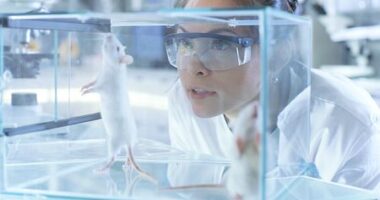Additional Genetic Changes May Contribute to Bardet-Biedl Symptom Severity

People with Bardet-Biedl syndrome (BBS) have nearly two times as many rare secondary mutations in BBS-associated genes than their healthy peers, and in a non-random pattern, according to a recent study.
The findings, along with the presence of interactions between these mutations, suggest that additional genetic variation may contribute to the variability and severity of BBS’s symptoms.
“It is imperative that we broaden our search for answers beyond the single causal gene,” Nico Katsanis, PhD, the study’s senior author, said in a press release. Katsanis is director of the Advanced Center for Translational and Genetic Medicine at the Stanley Manne Children’s Research Institute of Lurie Children’s Hospital of Chicago.
While further research is needed to explore such contributions, these discoveries may help better understand the genetic complexity of BBS and other so-called “single-gene” diseases, in addition to opening new therapeutic avenues.
“The work also gives us multiple potential entry points for therapies: some disease-causing genes are difficult to target — but their neighbors might be amenable,” added Katsanis, who is also a professor of pediatrics and cell and molecular biology at Northwestern University Feinberg School of Medicine.
The study, “Evidence for secondary-variant genetic burden and non-random distribution across biological modules in a recessive ciliopathy,” was published in the journal Nature Genetics.
Mutations in at least 20 different genes (BBS1–BBS20) have been associated with the development of BBS, a rare “single gene” disease affecting body weight regulation, vision, and cognitive and kidney functions.
Most BBS genes provide information to produce proteins involved in the formation of three different protein complexes — the BBSome, the transition zone complex, and the chaperonin complex — involved in the regulation of primary cilia, cellular structures that act like signaling antennas.
BBS symptoms and severity vary greatly between patients, even among those in the same family, challenging the disorder’s diagnosis and management. This symptom variability, along with reports of secondary mutations in BBS genes other than the main disease-causing gene suggest the influence of an additional genetic burden that makes the primary mutation’s effect more (or less) potent.
However, assessing such genetic burden is particularly challenging in rare disorders due to the low frequency of main and secondary mutations.
Now, researchers at the Stanley Manne Children’s Research Institute and their colleagues provided evidence of a secondary-variant burden in BBS.
Using a series of genetic and functional approaches, they analyzed the genetic data of 277 BBS patients with known disease-causing mutations in one of 17 BBS genes, and 872 unaffected individuals used as controls.
The team evaluated whether BBS patients showed a greater number of secondary variants in these 17 genes beyond the main disease-causing mutation, and whether this additional variation was distributed in a non-random way. The confirmation of these two features would indicate the contribution of second-site mutations to the disease.
Results from two smaller groups of patients and controls were confirmed subsequently in two larger groups. A group of 50 people with a clinical genetic disorder other than BBS and who carried mutations in one of the BBS genes also was included.
The findings showed that BBS patients had nearly twice as many rare secondary mutations in BBS genes than controls. Their rare nature is consistent with natural selection against them, “indicating that they are probably [damaging] and occurring at functional positions,” the researchers wrote.
The investigators also found a significant over-representation of second-site variants in chaperonin complex-genes, “suggesting that this module potentially has the most physiologically potent interaction capability,” they added.
Additional gene interaction experiments using zebrafish supported this hypothesis, as all observed epistatic interactions involved one of chaperonin complex-genes. Epistatic interactions are those resulting in effects greater or smaller than those predicted by the addition of each variant’s effects.
“These data indicate a complex genetic architecture for BBS,” the researchers wrote, adding that “understanding the biochemical interplay between the chaperonin module and the BBSome will probably further improve our understanding of the role of the additional variation.” (Notably, the chaperonin complex was has been shown to interact with the BBSome.)
Further studies using detailed clinical data on disease symptoms and onset are needed to determine the contribution of this genetic burden to BBS symptoms, the team said.
“We have always known that disease causality was not binary, but a continuum, but we lacked the proof and the tools to detect it,” Katsanis said, noting that now he believes “we have a new depth of resolution to understand the problem better.”
“To me, this is not too different from the development of tools that increased the magnification of telescopes. Now we can see deeper, better, and start making predictions about diseases: why they happen, why the progress the way they do,” he added.
“We speculate that the systematic measurement of burden of other genetically heterogeneous disorders in which all of the causal genes are considered as one baseline entity … will reveal similar burden observations,” the researchers concluded.
The team is now applying these concepts to other related disorders, paying close attention to variant interactions that worsen or lessen disease severity.




